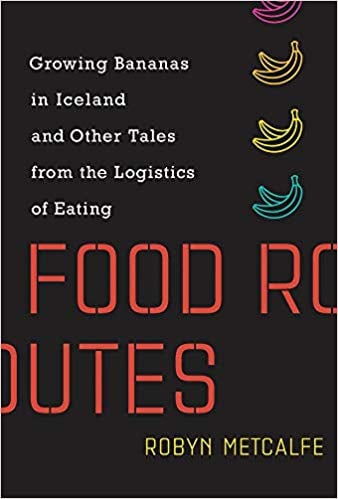You have /5 articles left.
Sign up for a free account or log in.
 Food Routes: Growing Bananas in Iceland and Other Tales From the Logistics of Eating by Robyn Metcalfe
Food Routes: Growing Bananas in Iceland and Other Tales From the Logistics of Eating by Robyn Metcalfe
Published in March 2019
A few years ago, we started the process of college visits with my daughters. What was the most noticeable difference that we observed on our campus tours, compared to when my wife and I were undergraduates in the late 1980s?
Not the classrooms -- while there were some active learning spaces with flat spaces and movable furniture, most lecture halls looked mostly unchanged. And not the residence halls, as freshman housing seems remarkably little evolved over the decades.
What seems to have changed in 30 years -- at least from what we observed -- is the food.
Nowadays, campus dining is miles improved from when I was an undergraduate. Back in 1987, the campus eating options most resembled a high school cafeteria. Long lines for institutional food, plus options for pizza and burgers.
Visit a campus dining hall today, and you are likely to encounter a multitude of food stations offering freshly prepared delicacies. The salad bar is a thing to behold.
Campus dining facilities are also likely to feature signage describing the origins of the food. Every university dining service seems to want to boast of serving locally sourced food items.
The assumption, which I never questioned before reading Food Routes, is that locally grown food is always superior to food shipped from faraway places. One fact that I learned in Food Routes, however, is that there are some environmental pros and cons to local food.
On the one hand, local food supply networks are beautiful things -- as sourcing ingredients from local farmers and suppliers enables buyers to have some visibility and say into the conditions in which the food is produced. On the other hand, the growth of local food sourcing has resulted in the need for many small trucks to be on the road for lots of pickups and deliveries. Sometimes, these trucks are not very full.
This compares to long-distance food supply chains, which optimize the efficiency of transportation by using larger containers (trains and semitrucks) that are packed tightly. It may be that our love of local food sourcing is contributing to a proliferation of carbon-burning vehicles. Who knew?
When it comes to how our food gets from the farm to our plate, nothing is simple. Our food supply chains are complex and mostly invisible. Metcalfe does an admirable job of trying to make the process of how ingredients are produced, shipped, combined and delivered transparent and understandable.
Food Routes takes us on a tour of where all the food comes from, and how it travels, which makes up the ingredients in the pizzas from a single NYC restaurant. The web of interlocking farms, food processors and distributors that go into enabling us to enjoy a slice of pepperoni pizza is truly dizzying.
Those outside the grocery and restaurant businesses may be surprised to learn how quickly the logistics of food supply chains are evolving. There is both consolidation of food company conglomerates and a proliferation of small organic producers.
Advances in artificial intelligence, blockchain and big data will combine to fundamentally alter how food is produced and distributed.
The logistics of food would make for an excellent course. Unpacking where our food comes from and how it arrives on our plates would make for a terrific interdisciplinary field of study.
Can you recommend other books about the logistics of food?
What are you reading?








